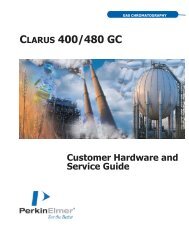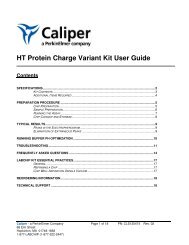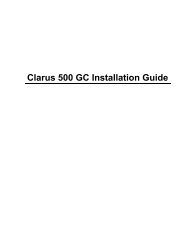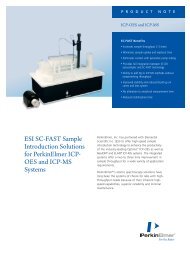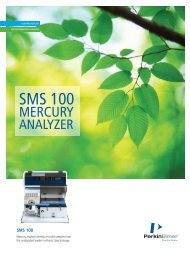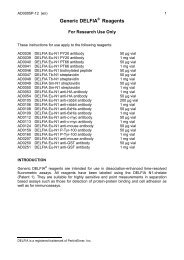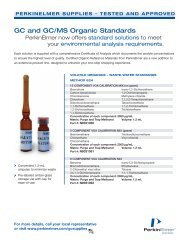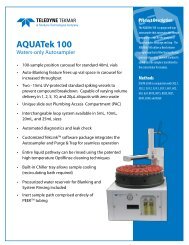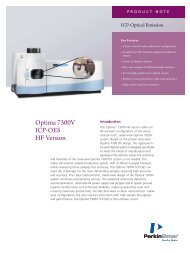1450 MicroBeta JET - Microplate Scintillation and ... - PerkinElmer
1450 MicroBeta JET - Microplate Scintillation and ... - PerkinElmer
1450 MicroBeta JET - Microplate Scintillation and ... - PerkinElmer
You also want an ePaper? Increase the reach of your titles
YUMPU automatically turns print PDFs into web optimized ePapers that Google loves.
in the case of a six detector <strong>MicroBeta</strong> <strong>JET</strong> fitted with<br />
one injector module, up to six different reagents can<br />
be dispensed across each plate.<br />
• Counting modes include single <strong>and</strong> dual label CPM,<br />
single <strong>and</strong> dual label DPM, ParaLux count mode <strong>and</strong><br />
luminescence counting.<br />
• Crosstalk correction is provided for optical <strong>and</strong><br />
isotopic crosstalk in samples that can not be prepared<br />
in non-crosstalk format.<br />
• Instrument shelf stacking system provides easy access<br />
<strong>and</strong> identification of samples.<br />
• Optimized counting conditions for all the commonly<br />
counted isotopes are included as st<strong>and</strong>ard. Settings for<br />
other beta <strong>and</strong> gamma isotopes can be made by the user.<br />
• Instrument software run on a Windows® XP interface.<br />
St<strong>and</strong>ard software features include a Windows<br />
Workstation interface, Spectrum plot, ASCII, Excel®<br />
or CSV filing, column <strong>and</strong> or plate formats <strong>and</strong><br />
context specific HELP function.<br />
• Counting control protocols can be edited to include<br />
repeat, replicate <strong>and</strong> cycle counting.<br />
• Count delay options can be used for an automatic,<br />
unattended assay start after an incubation period.<br />
Cycle delay <strong>and</strong> plate delay are also possible.<br />
• Live display with 8 x 12 or 4 x 6 live display provides<br />
instant feedback to the user.<br />
• Counting comm<strong>and</strong>s such as ‘next sample’ or ‘next<br />
assay’ comm<strong>and</strong>s are available while the counter<br />
is operating.<br />
• Count termination is either by fixed time or by<br />
counting precision.<br />
• Optimized counting conditions for all the commonly<br />
counted isotopes are included as st<strong>and</strong>ard. Settings<br />
for other beta <strong>and</strong> gamma isotopes can be made by<br />
the user.<br />
• Up to 100 normalizations can be stored <strong>and</strong> linked to<br />
any one of 100 counting protocols to provide corrections<br />
for detector efficiencies <strong>and</strong> possible background<br />
<strong>and</strong> crosstalk.<br />
• Up to 100 st<strong>and</strong>ardizations can be stored <strong>and</strong> linked<br />
to any one of 100 counting protocols to provide DPM<br />
results that are also corrected for detector efficiencies<br />
<strong>and</strong> possibly crosstalk.<br />
• ParaLux Count Mode for scintillation proximity<br />
assays fully utilizes the advantage of twin photomultiplier<br />
tubes. Compared to all other methods, counting<br />
efficiency is increased by up to 500%. The ultrasensitive,<br />
high dynamic range quench parameter,<br />
AQP(I), provides superior DPM calculations.<br />
• Easy DPM includes pre-stored quench data that is<br />
modified by counting just two st<strong>and</strong>ard samples.<br />
Errors in sample preparation <strong>and</strong> lengthy st<strong>and</strong>ardization<br />
counting times are thereby avoided.<br />
• Three counting windows enable counting data from<br />
three separate <strong>and</strong> independent counting regions to<br />
be obtained.<br />
• Background subtraction enables fixed samples or<br />
values obtained from detector normalizations to be<br />
deducted from unknown CPM values.<br />
• Plate mapping enable plate layouts to be entered for<br />
each protocol so that specific positions are counted.<br />
• Chemiluminescence correction is an automatic<br />
correction for unwanted single photon activity.<br />
This is based on delayed coincidence <strong>and</strong> dual<br />
MCA technology.<br />
• Half-life correction is a correction facility for CPM<br />
<strong>and</strong> DPM values. The zero time may be the start of<br />
the assay or a specified date <strong>and</strong> time.<br />
• Chemiluminescence correction is an automatic<br />
correction for unwanted single photon activity.<br />
This is based on delayed coincidence <strong>and</strong> dual<br />
MCA technology.<br />
• Statistics monitor detects <strong>and</strong> reports distorting<br />
contributions from static electricity.<br />
• DPM monitor reports samples outside the range of<br />
the quench curve.<br />
• Freely-selectable data output options in addition to<br />
st<strong>and</strong>ard count rate information include sample/plate<br />
ID, quench parameters, spectrum plot, date <strong>and</strong> time,<br />
CPM <strong>and</strong> DPM monitors <strong>and</strong> statistical analysis.<br />
Output can be customized in either column <strong>and</strong>/or<br />
plate format.<br />
• EasyGLP routines are included for monitoring detector<br />
performance by counting st<strong>and</strong>ard samples. Results<br />
can be printed <strong>and</strong> saved to file.<br />
• Instrument-based diagnostic service routines are<br />
used to verify instrument performance.<br />
• Passwords protection for counting, normalization<br />
<strong>and</strong> st<strong>and</strong>ardization protocols is included.<br />
2



